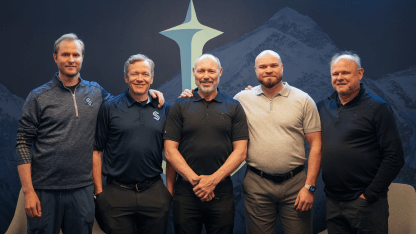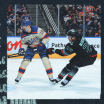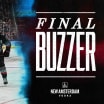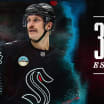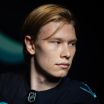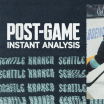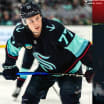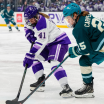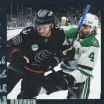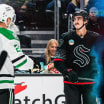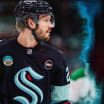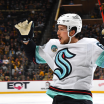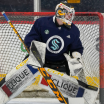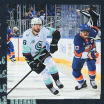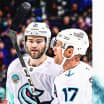All Kraken amateur scouts are gathered in Seattle this week, arriving from North America and Europe, to put together the team’s prospect rankings for the 2025 NHL Draft in late June. For a trio of Swedes, it’s an opportunity to connect with the larger group of fellow scouts based in North America and advocate for the players in Europe they have identified as potential picks this summer.
You might say the Kraken are stacked in Sweden with scouts Pelle Eklund and Marcus Fingal and supervisor of European scouting Axel Alavaara. While Fingal mostly scouts Swedish U20 junior-level players in the country, Eklund and Alavaara seek out players in Sweden and throughout Europe over the course of a season.
“I think we are fortunate to have three guys in Sweden,” said Alavaara, a former defense-first defenseman who played 12 seasons in his home country’s top pro league, one in the top Swiss league and three more in Germany’s top league. “Not all clubs, usually it’s one or two. And the good part is I live up north, Pelle lives in the middle, and Marcus lives in the south. From that perspective, we don't have to travel so much from the start to recognize the players and see them early season.”
Along with their scouting talents and experience as players and coaches – Eklund played nine seasons for Philadelphia and starred for the Flyers in the 1987 Stanley Cup Final – the Swedish scouts are traversing a country that is home to 10.1 percent of NHL players. Per QuantHockey, on average, nearly 10 percent of NHL Draft picks every summer are Swedish-born players. Only Canada (43.6) and the U.S. (26.6) have higher percentages, with Russia (6.6) and Finland (4.6) rounding out the top five (the Kraken have a Russia-based scout, Alexsandr Plyushev, and a Finland-based scout, Sasu Hovi).
While no Swedish prospects were selected in the 2024 first round, there were plenty of picks in Rounds 2 and 3. Six Swedes were among the 32 first-round picks in 2023 and four more in 2022. What’s more, only the U.S., Canada and Russia boast more youth players, with Sweden, which has the 98th largest population in the world, compared to Russia (9th). In this springtime of mock drafts, many observers project two Swedish prospects, center Anton Frondell and winger Victor Eklund, who are teammates in Sweden’s second-tier pro league, to be picked in the top 10 to 15. The NHL Central Scouting ranking of international players lists the two young Swedes as No. 1 and No. 2, respectively, and identifies seven Swedish players in its top 10.
Seattle fans don’t have to look hard for an example of a top draft pick from Sweden. Kraken stalwart defenseman Adam Larsson was selected fourth overall by the New Jersey Devils in 2011. And if you are looking for lower-round value, consider 2016 sixth-rounder Jesper Bratt (also picked by New Jersey), who has already played eight NHL seasons and averaged 26 goals per season over the last four hockey years.
Syncing Up Itineraries and Player Evaluations
Eklund and Fingal were hired in October 2020 as part of stocking up on scouts ahead of the 2020-21 season in preparation for the Kraken’s inaugural NHL Draft in 2021. Alavaara joined as European scouting supervisor in January 2024.
“I have the role, but it’s more that we work together,” said Alavarra, smiling, clearly a man who loves his job. “We talk almost on a daily basis, at least a couple of times a week, about how we cover everything and who's going where. Marcus is mostly doing Sweden. He goes to some national team tournaments in Europe as well. Pelle and I are covering the whole of Europe, from Czechia to Switzerland to Slovakia and more. We go to national team tournaments too [for the efficiency of seeing top players from each country competing against each other].”
The three scouts go to where the prospects are, starting with tournaments beginning in August, but when Swedish regular seasons start for draft-eligible prospects, each of them looks to get eyes on all players before Eklund and Alavaara begin to travel to other countries. Fingal said the early season focus is on the U20 leagues, while the U18 scouting is “more to the end of the season” to see younger kids who have developed (or not) during the course of the year.
“Usually the first tournament is in November,” said Eklund, who played five more seasons in the top Swedish pro league (including a MVP season) after his NHL career, then took on European scouting roles with the Montreal Canadiens and Edmonton Oilers. “I want to try to see all the under-20 teams in Sweden before that.”
The Swedish scouts start with a list of underage players from the previous season that they agree are worth following closely in their upcoming draft year. Along with who is closest to games geographically, they coordinate which players each are focusing on and try to economize their assignments so they don’t double up on Swedish U20 games. They seldom attend the same game, the exception being toward the end of the season, as the scouts are looking for agreement on a player’s upside.
One part of it is what Alavaara says is, “Communication to split it up so we have enough viewings of every player and we are confident in our opinions.” Eklund said they all watch a lot of video on the identified prospects, but he “likes to see them in person first” before video study. Another plus is that the three men are amiable colleagues. In fact, when Alavaara left the Buffalo organization as a Europe-based scout, the Sabres asked Alavaara to interview a younger scout who was scouting for a Swedish team. That young man was Fingal.
“We are fortunate because we have six eyes,” said Fingal during a break from this week’s meetings. “If I watch a player and I'm not the biggest fan, then I talk to Pelle or Axel, and they might like the player. I want to go back and watch them again and see if I missed something. It’s a strength we have.”
Looking for Kraken Kind of Prospects
Similar to all Seattle scouts, the trio in Sweden is looking for players with skating skills that project to the NHL level, plus a high hockey IQ. Those are must-have attributes, same for compete level and outstanding character. The three scouts are all diligent and comprehensive about talking with coaches and team staff, from executives to trainers to equipment staff, along with anyone who can speak to a player’s attributes.
“We have guidelines when we interview the players,” said Alavaara. “Guidelines like accountability, team first, resilience to build our own picture, and make up our minds about the player. At the end of the day, you have to build your own picture, make up your mind about the player. Is he checking the boxes we are looking for?"
Eklund is a realist about how to size up kids who, in many cases, have not even reached their 18th birthday until sometime later in the season or before the Sept. 15 cutoff.
"Every player has some flaws, not a five or four-and-a-half in every category," said Eklund. "But you have to put that into perspective. Is it going to be good enough? ... say skating, is there room to develop because the player has such good hockey sense and how play with and without the puck. You have to consider the strengths. It's not easy. You have to really put all the boxes together because not too many players are top-end in every category, right?"
“The one common thing is they have a drive,” said Alavaara, smoothly picking up where his esteemed colleague left off. “If they want to excel, they want to be better, they want to practice. If they're curious, that's something from my experience that is important. Does the player have the drive to become better and be curious about ‘how can I improve?’”

